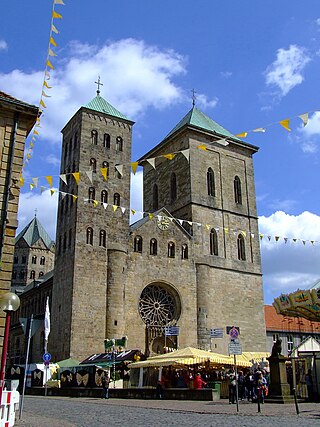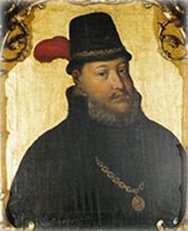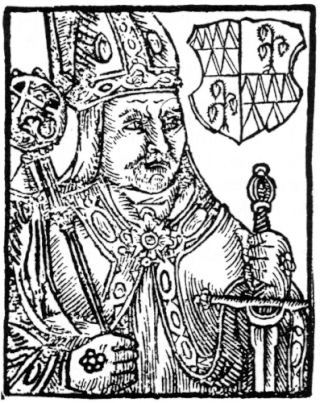Related Research Articles

The Archbishop of Cologne is an archbishop governing the Archdiocese of Cologne of the Catholic Church in western North Rhine-Westphalia and is also a historical state in the Rhine holding the birthplace of Beethoven and northern Rhineland-Palatinate in Germany and was ex officio one of the Prince-electors of the Holy Roman Empire, the Elector of Cologne, from 1356 to 1801.
Adolf of Altena, Adolf of Berg or Adolf of Cologne, was Archbishop of Cologne from 1193 to 1205.

The Diocese of Osnabrück is a Latin Church ecclesiastical territory or diocese of the Catholic church in Germany. The diocese was originally founded circa 800. It should not be confused with the smaller Prince-Bishopric of Osnabrück–an ecclesiastical principality of the Holy Roman Empire until 1803–over which the bishop, as prince-bishop, exercised both temporal and spiritual authority.

The Counts of Schauenburg and Holstein were titles of the Frankish Empire. The dynastic family came from the County of Schauenburg near Rinteln on the Weser in Germany. Together with its ancestral possessions in Bückeburg and Stadthagen, the House of Schauenburg ruled the County of Schauenburg and the County of Holstein. The comital titles of Holstein were subject to the liege lord, the Dukes of undivided Saxony till 1296, and thereafter the Dukes of Saxe-Lauenburg.

Johann Gropper was a German cardinal and church politician of the Reformation period.
The Diocese of Ratzeburg is a former diocese of the Catholic Church. It was erected from the Diocese of Oldenburg c. 1050 and was suppressed in 1554. The diocese was originally a suffragan of the Archdiocese of Hamburg; in 1072 it became a suffragan of the merged entity — the "Archdiocese of Hamburg and the Diocese of Bremen". The territory of the diocese was located in what is today the states of Schleswig-Holstein and Mecklenburg-Vorpommern in Germany. The cathedral church of the diocese — dedicated to Ss. Mary and John — is still extant in the city of Ratzeburg. Following its suppression as part of the Protestant Reformation, the remaining Catholic adherents were only represented by the Apostolic Vicariate of Northern Germany. The whole territory of the diocese is today included in the Roman Catholic Archdiocese of Hamburg.
Eberhard Billick was a German theologian instrumental in keeping the city of Cologne Catholic during the Reformation.

Otto IV of Schaumburg was a German nobleman. He was a ruling Count of Schauenburg and of Holstein-Pinneberg. He was a son of Jobst I and his wife Mary of Nassau-Siegen, a daughter of Count John V of Nassau-Siegen.

The County of Schaumburg, until ca. 1485 known as Schauenburg, was a state of the Holy Roman Empire, located in the present German state of Lower Saxony. Its territory was more or less congruent with the present district Landkreis Schaumburg.

The Prince-Bishopric of Paderborn was an ecclesiastical principality (Hochstift) of the Holy Roman Empire from 1281 to 1802.

Hermann IV of Hesse was the Archbishop-Elector of Cologne from 1480 to 1508 and the Prince-Bishop of Paderborn from 1498 to 1508.
Anton of Schauenburg was Archbishop-Elector of Cologne from 1557 to 1558.

Bernhard VIII, Count of Lippe was from 1547 until his death in 1563 ruling the County of Lippe.

The County of Holstein-Pinneberg, also known as the County of Schauenburg and Holstein-Pinneberg, was a small territory which existed from 1290 until 1640, centred around Pinneberg in modern-day Schleswig-Holstein, Germany.
Jobst I, Count of Holstein-Schauenburg (1483-1531) was a German nobleman. He was the ruling Count of Schauenburg and Holstein-Pinneberg from 1527 until his death. He was a son of John IV and his wife, Cordula of Gemen.

Countess Mary of Nassau-Siegen, German: Maria Gräfin von Nassau-Siegen, official titles: Gräfin zu Nassau, Vianden und Diez, was a countess from the House of Nassau-Siegen, a cadet branch of the Ottonian Line of the House of Nassau, and through marriage Countess of Holstein-Schauenburg-Pinneberg.

Bruno von Schauenburg was a nobleman and Catholic priest of German descent, bishop of Olomouc in 1245–1281. He was one of the main advisors and diplomats of the Czech kings: Wenceslaus I of Bohemia, and especially Ottokar II of Bohemia, for whom he was the "right hand". As a bishop in history of Moravia he is known thanks to colonization and his role in founding many new towns.

Hermann of Schleswig, also known as Hermann of Klosterrath, was a titular bishop of Schleswig, canon and possibly also scribe at Lund Cathedral. He entered the monastery of Rolduc at an early age, and after failing to become abbot of the monastery eventually left for Lund. He provided several services to the bishops of Lund and was appointed to become bishop of Schleswig, but the local clergy had elected Occo of Schleswig in 1137 as their bishop and refused to accept Hermann. He therefore remained in Lund, where he is buried in the crypt of Lund Cathedral.
References
- ↑ New Advent website, Cologne page Adolph III of Schauenburg (1546-56) took strong measures against the preachers brought in by Hermann, and published vigorous decrees against immoral priests. His brother Anton (1556-58) followed a similar course.
- ↑ Catholic Hierarchy website, Archdiocese of Cologne page
- Norbert Trippen, Geschichte des Erzbistums Köln (Cologne, 2008)
- Robert Haass, "Adolf III", in Neue Deutsche Biographie, Vol. 1 (Berlin: Duncker & Humblot, 1953), pp 83f.